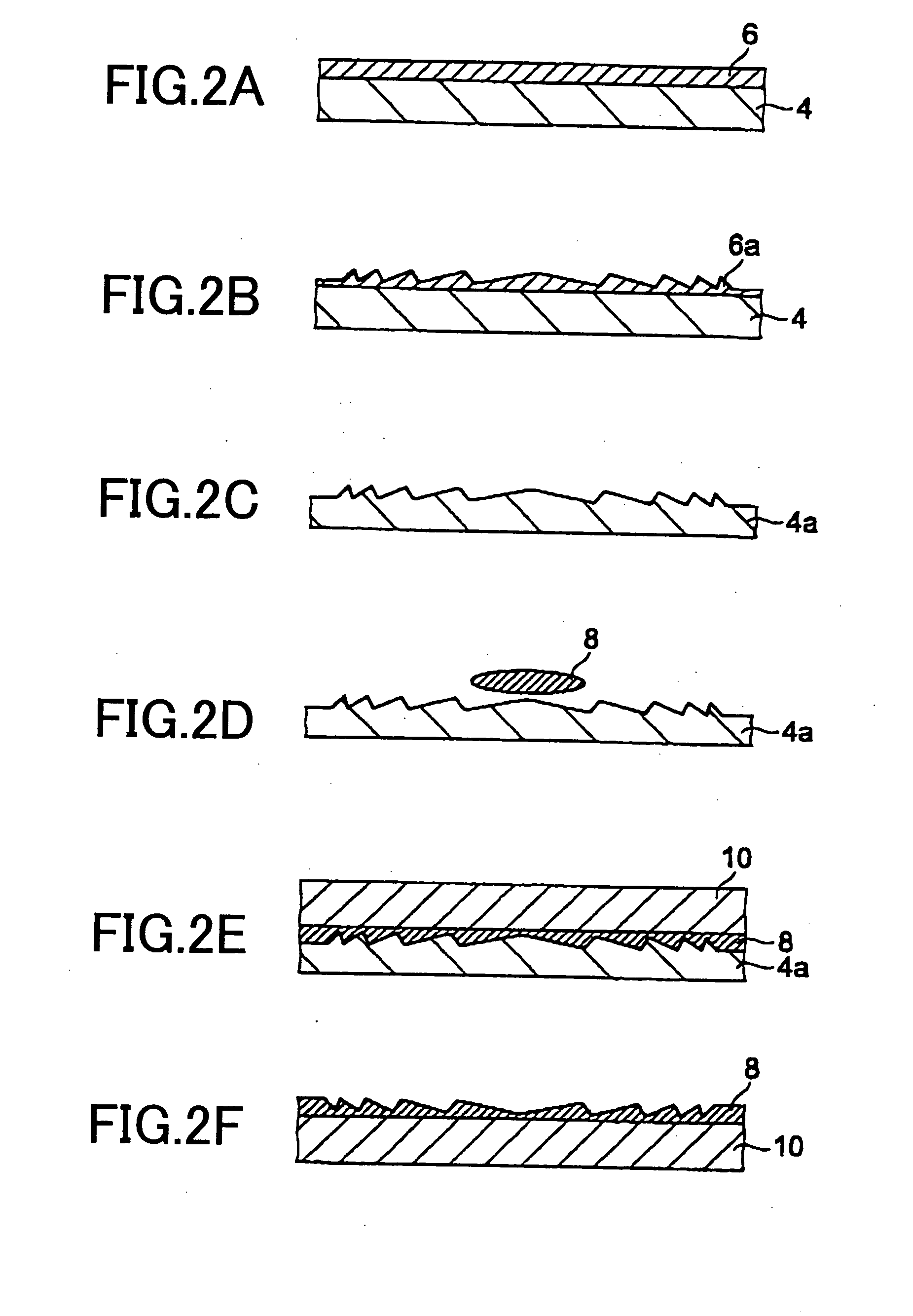Method and mold for fabricating article having fine surface structure
a surface structure and fine technology, applied in the field of fine structure fabrication on the surface, can solve the problems of poor mass-productivity, expensive apparatus, and inability to be put into practical us
- Summary
- Abstract
- Description
- Claims
- Application Information
AI Technical Summary
Benefits of technology
Problems solved by technology
Method used
Image
Examples
second example
[0133] An optical element used in optical communication, for example, for coupling two fibers, was fabricated by a method shown in the second example.
[0134] The optical element includes a number of lenses each having a diameter of 50 .mu.m made of synthetic silica. The curvature radius of each lens was 6.16 .mu.m, and the height of each lens was 28.0 .mu.m.
[0135] This optical element was fabricated following the procedure below.
[0136] (1) It was decided to fabricate a silicon mold by transferring an object surface shape onto a silicon substrate, and the surface shape of the mold had a height equal to the object height 28.0 .mu.m multiplied by a factor of (15.5 / 28.0), in other words, to fabricate a mold scaled down by 0.55 relative to the object surface shape, that is, n=1.82. When transferring the object surface shape from a resist onto the silicon substrate, the selection ratio was set to be 1.0.
[0137] (2) After transferring the surface shape from the resist to the silicon substrat...
third example
[0179] Below, a third example of a method of fabricating an optical element the same as that illustrated in FIGS. 4A through 4D, and FIGS. 5A through 5D is described below. This optical element, for example, is used for coupling two fibers. In this example, a detailed configuration of the optical element is introduced, and it is represented by a reference number 100.
[0180] FIGS. 6A and 6B are a plan view and a cross-sectional view, respectively, showing a configuration of the optical element 100, where the cross-sectional view in FIG. 6B is obtained along the X-X line in FIG. 6A.
[0181] As shown in FIGS. 6A and 6B, the optical element 100 includes a large number of lenses 102 formed on two sides of a synthetic silica substrate 110. The lenses 102 are arranged in a matrix manner on each side of the silica substrate 110. Each of the lenses 102 is 0.784 mm in diameter (.PHI..sub.0), and 40 .mu.m in height (H.sub.0).
[0182] As shown in FIG. 6A, the lenses 102 on the two sides of the silic...
fourth example
[0263] A fourth example of a method of fabricating an optical element the same as that illustrated in FIGS. 6A and 6B, or in FIGS. 7A and 7B is described below. The optical element for this example is used for coupling two fibers.
[0264] In this example, a preliminary surface structure was fabricated following the steps shown in FIGS. 13A and 13B.
[0265] FIGS. 13A and 13B are cross-sectional views showing the steps of forming a preliminary surface structure of the optical element 100 using a method of the fourth example.
[0266] First, a mask used in lithography for shielding the lenses 102 was prepared. The diameter of each shielding portion of the mask was essentially the same as the object diameter of each of the lenses 102.
[0267] In the step shown in FIG. 13A, on a silica substrate 210, a photo-conducting material 214 was applied uniformly to a thickness of 5 .mu.m by using a spinning coater. The photo-conducting material 214 used here was the product OFPR-5000-500 of Tokyo Ohka Kog...
PUM
| Property | Measurement | Unit |
|---|---|---|
| Time | aaaaa | aaaaa |
| Thickness | aaaaa | aaaaa |
| Shrinkage | aaaaa | aaaaa |
Abstract
Description
Claims
Application Information
 Login to View More
Login to View More - R&D
- Intellectual Property
- Life Sciences
- Materials
- Tech Scout
- Unparalleled Data Quality
- Higher Quality Content
- 60% Fewer Hallucinations
Browse by: Latest US Patents, China's latest patents, Technical Efficacy Thesaurus, Application Domain, Technology Topic, Popular Technical Reports.
© 2025 PatSnap. All rights reserved.Legal|Privacy policy|Modern Slavery Act Transparency Statement|Sitemap|About US| Contact US: help@patsnap.com



